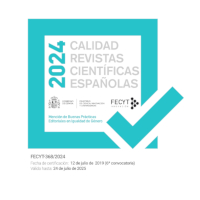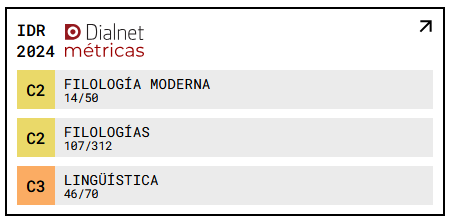Disposable (Textual) Bodies
Popular Prostitute Narratives and the Composite Novel
DOI:
https://doi.org/10.18172/jes.5964Keywords:
novel, canon, popular fiction, intertextuality, textual assemblage, prostitute narrativesAbstract
The present article compares two coeval authors, Daniel Defoe (1660-1731) and Jane Barker (1652–1732), who stand on opposite sides of the political and religious spectrum, to analyse the ways in which they engage with popular prostitute stories in Moll Flanders (1722) and the Patch-Work narratives (1723, 1726), respectively. This contribution, then, offers novel insights into these writers’ work, exploring the ways in which Defoe rewrites this form of popular fiction to conform to his middle-class fantasy of personal development, and how Barker responds both to Defoe’s tales of prostitute ascent and the general taste for this fiction from her own ideological perspective. It will also expose their similarities, as they construct composite literary bodies of many different prostitute narratives, and emphasize the need to understand the novel as an assemblage of voices, genres and sociomaterial aspects.
Downloads
References
Attwood, Nina. The Prostitute’s Body: Rewriting Prostitution in Victorian Britain. Pickering & Chatto, 2011.
Bertelsen, Lance. “Popular Entertainment and Instruction, Literary and Dramatic: Chapbooks, Advice Books, Almanacs, Ballads, Farces, Pantomimes, Prints and Shows.” The Cambridge History of English Literature, 1660–1780, edited by J. Richetti, Cambridge UP, 2005, pp. 61–86. DOI: https://doi.org/10.1017/CHOL9780521781442.005
Binhammer, Katherine. The Seduction Narrative in Britain, 1747-1800. Cambridge UP, 2009. DOI: https://doi.org/10.1017/CBO9780511635496
Borham-Puyal, Miriam. Contemporary Rewritings of Liminal Women. Echoes of the Past. Routledge, 2020. DOI: https://doi.org/10.4324/9780429297823
Borham-Puyal, Miriam. “Jemima’s Wrongs: Reading the Female Body in Mary Wollstonecraft’s Prostitute Biography.” International journal of English studies, vol. 19, no.1, 2019, pp. 97–112. http://doi.org/10.6018/ijes.341191 DOI: https://doi.org/10.6018/ijes.341191
Borham-Puyal, Miriam. Quijotes con enaguas. Encrucijada de géneros en el siglo XVIII británico. JPM Ediciones, 2015.
Breashears, Caroline. “Scandalous Categories: Classifying the Memoirs of Unconventional Women.” Philological Quaterly, vol. 82, no. 2, 2003, pp. 187-212.
Bree, Linda. 2011. “Introduction.” Moll Flanders, edited by Linda Bree, Oxford UP, 2011, pp. ix-xxvi.
Brissenden, Robert Francis. Virtue in Distress. Studies in the Novel of Sentiment from Richardson to Sade. Macmillan Press, 1974.
Brown, Bill. “Re-Assemblage (Theory, Practice, Mode).” Critical Enquiry vol. 46, no. 2, 2020, pp. 259-303. DOI: https://doi.org/10.1086/706678
Butler, Judith. Bodies that Matter. On the Discursive Limits of Sex. Routledge, 1993.
Butler, Judith. Dispossession: The Performative in the Political. Conversations with Athena Athanasiou. Polity Press, 2013.
Cahill, Samara Anne. “Novel ‘Modes’ and ‘Indian Goods’: Textilic Nationalism in A Patch-Work Screen for the Ladies and The Lining of the Patch-Work Screen.” Studies in Eighteenth-Century Culture, vol. 44, 2015, pp. 163-184. https://doi.org/10.1353/sec.2015.0016 DOI: https://doi.org/10.1353/sec.2015.0016
Carnell, Rachel. Partisan Politics, Narrative Realism, and the Rise of the British Novel. Palgrave Macmillan, 2006. DOI: https://doi.org/10.1057/9781403983541
Cascardi, Anthony J. “Don Quixote and the invention of the novel.” The Cambridge Companion to Cervantes, edited by Aanthony J. Cascardi, Cambridge UP, 2002, pp. 58-79. DOI: https://doi.org/10.1017/CCOL0521663210.004
Clarke, Norma. The Rise and Fall of the Woman of Letters. Pimlico, 2004.
Defoe, Daniel. Moll Flanders, edited by Linda Bree, Oxford UP, 2011. DOI: https://doi.org/10.1093/owc/9780192805355.001.0001
Donovan, Josephine. “Women and the Framed Novelle: a Tradition of their Own.” Signs, vol. 22, no. 4, 1997, pp. 947-980. DOI: https://doi.org/10.1086/495215
Doody, Margaret Anne. The True Story of the Novel. Rutgers UP, 1996.
Eger, Elizabeth, Charlotte Grant, Clíona Ó'Gallchoir and Penny Warburton. “Introduction: women, writing and representation.” Women, Writing and the Public Sphere, 1730-1830, edited by Elizabeth Eger, Charlotte Grant, Clíona Ó'Gallchoir and Penny Warburton, Cambridge UP, 2001, pp. 1-26.
Ellis, Markman, and Ann Lewis. “Introduction: Venal Bodies –Prostitutes and Eighteenth-Century Culture.” Prostitution and Eighteenth-Century Culture: Sex, Commerce and Morality, edited by Ann Lewis and Markman Ellis, Routledge, 2012, pp. 1-16.
Figueroa Dorrego, Jorge. “Exposing the Whore: Misogyny in Prostitute Narratives of Restoration England.” Revista Canaria de Estudios Ingleses, vol. 79, 2019, pp. 33-53. https://doi.org/10.25145/j.recaesin.2019.79.03 DOI: https://doi.org/10.25145/j.recaesin.2019.79.03
Joule, Victoria. “‘Heroines of their own romance’: Creative Exchanges between Life‐Writing and Fiction, the ‘Scandalous Memoirists’ and Charlotte Lennox.” Journal for Eighteenth‐Century Studies, vol. 37, no. 1, 2014, pp. 37-52. https://doi.org/10.1111/1754-0208.12033 DOI: https://doi.org/10.1111/1754-0208.12033
Lennox, Charlotte. The Female Quixote, or, The Adventures of Arabella, edited by Margaret Dalziel, Oxford UP, 1973.
McKeon, Michael. The Origins of the English Novel, 1600-1740. The Johns Hopkins UP, 1987.
Olsson, Lena. “Introduction.” The Prostitute’s Life: Sally Salisbury and Fanny Hill, edited by Lena Olsson, Pickering & Chatto, 2004, pp. vii-xviii.
Richetti, John J. The English Novel in History. 1700-1780. Routledge, 1999.
Richetti, John J. Popular Fiction Before Richardson. Narrative Patters: 1700-1739. 1969. Oxford UP, 1992. DOI: https://doi.org/10.1093/acprof:oso/9780198112631.001.0001
Rogers, Pat. “Crusoe’s Home.” Essays in Criticism, vol. 24. no. 4, 1974, pp. 375-390. DOI: https://doi.org/10.1093/eic/XXIV.4.375
Rosenthal, Laura J. Infamous Commerce. Prostitution in Eighteenth-Century British Literature and Culture. Cornell UP, 2006.
Rosenthal, Laura J. “Introduction.” Nightwalkers: Prostitute Narratives from the Eighteenth Century, edited by Laura J. Rosenthal, Broadview Press, 2008, pp. ix-xxx.
Schofield, Mary Anne. “‘Descending Angels’ Salubrious Sluts and Pretty Prostitutes in Haywood’s Fiction.” Fetter’d or Free? British Women Novelists, 1670-1815, edited by Mary Anne Schofield and Cecilia Macheski, Ohio UP, 1987, pp. 186-200.
Schofield, Mary Anne. Masking and Unmasking the Female Mind. Disguising Romances in Feminine Fiction, 1713-1799. Associated University Presses, 1990.
Smith, Sharon. “Defoe’s The Complete English Tradesman and the Prostitute Narrative: Minding the Shop in Mrs. Elizabeth Wisebourn, Sally Salisbury, and Roxana.” Journal for Early Modern Cultural Studies, vol. 15, no. 2, 2015, pp. 27-57. http://doi.org/10.1353/jem.2015.0012 DOI: https://doi.org/10.1353/jem.2015.0012
Swenson, Rivka. “Representing Modernity in Jane Barker’s Galesia Trilogy: Jacobite Allegory and the Patch-Work Aesthetic.” Studies in Eighteenth-Century Culture, vol. 34, 2005, pp. 55-80. http://doi.org/10.1315/sec.2010.0022 DOI: https://doi.org/10.1353/sec.2010.0022
Swenson, Rivka. “Robinson Crusoe and the Form of the New Novel.” The Cambridge Companion to Robinson Crusoe, edited by J. Richetti, Cambridge UP, 2018, pp. 16-31. DOI: https://doi.org/10.1017/9781107338586.003
Thompson, Lynda M. The“scandalous memoirists”: Constantia Phillips, Laetitia Pilkington and the shame of ‘publick Fame’. Manchester UP, 2000.
Walker, Charles. “Authentick Memoirs of the Life, Intrigues, and Adventures of the Celebrated Sally Salisbury. With True Characters of her most Considerable Gallants.” Nightwalkers: Prostitute Narratives from the Eighteenth Century, edited by Laura J. Rosenthal, Broadview Press, 2008, 1-68.
Watt, Ian. The Rise of the Novel. Studies in Defoe, Richardson and Fielding. 1957. Pelican Books, 1981.
Wilson, Carol Shiner, editor. 1997. The Galesia Trilogy and Selected Manuscript Poems of Jane Barker. Oxford UP, 1997. DOI: https://doi.org/10.1093/oso/9780195086508.001.0001
Downloads
Published
How to Cite
Issue
Section
License
Copyright (c) 2024 Miriam Borham-Puyal

This work is licensed under a Creative Commons Attribution 4.0 International License.
The authors retain copyright of articles and authorize Journal of English Studies the first publication. They are free to share, redistribute, and/or reprint the article without obtaining permission from the publisher as long as they give appropriate credit to the editor and the journal.
Self-archiving is allowed too. In fact, it is recommendable to deposit a PDF version of the paper in academic and/or institutional repositories.
It is recommended to include the DOI number.
This journal is licensed under a Creative Commons Attribution 4.0 International LicenseFunding data
-
Ministerio de Ciencia, Innovación y Universidades
Grant numbers PID2022-137881NB-I00














